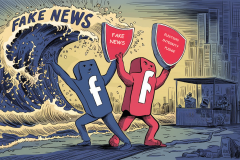Facebook is the social butterfly of Internet society, but as a company it has been a wallflower, reluctant to share any but the barest hints of its strategies and finances. Last Friday’s IPO coming-out party debuted the shy corporate entity in the realm of public companies and shareholder scrutiny. It’s one thing to “Like” an idea, but it’s another to believe in it. Are there enough believers to make Facebook’s long-term business model real?

Is Disruption Enough?
“Facebook is about to experience a new conundrum,” says Paul Papadimitriou, principal analyst with Monta Vista, Calif.-based Constellation Research. “Like it or not – and proponents of an open Web don’t – it has become a de facto public space, an agora, but it never truly wanted to go public, having to cope with the scrutiny of the markets.”
“The social network was well able to understand human behavior – that need to belong, to share, to participate, further accelerating the growth of reach and scope of collaboration in the process,” Papadimitriou continues. “That led to the first conundrum, the first wave of scrutiny: How do we define an online identity, with all the privacy questions linked to it? The second wave is now upon it: the scrutiny of the financial market. It will have to deliver earnings; it will have to prove it possesses a sustainable business model. The question is open as to whether the result will negate or accelerate its efforts to ‘disrupt.'”
“How are you going to churn all of that disruptive promise into realizable, sustainable, growth-focused revenue? Will all of this hype and all of this lofty expectation turn into a viable business? Because right now, that isn’t clear.”
-Carmi Levy, CTV News Channel, Yahoo Canada
In an earlier era, people questioned the legitimacy of attaching advertising to broadcast performances that are being reproduced for free. Those doubts were dispelled long ago, although the formulas for achieving profitability remain a stretch. Facebook is an experiment in attaching advertising to something more nebulous than prime-time TV: the activities of people saying “hi” to one another. The network has proven its capacity for attracting an audience, but its ability to sustain that audience and its long-term ability to monetize the activities from that audience are almost completely undefined.
Facebook’s very high initial valuation remains, to a significant degree, a product of faith: With this much of an audience and this popular of a brand, how can anything possibly go wrong?
The nucleus of Silicon Valley tends to measure a company’s value by its ability to disrupt, to change fundamental aspects of the market it serves (even if it serves that market for a very brief time). Should we begin applying a kind of formula, like a metric conversion, between a company’s ability to disrupt and its ability to produce? And if so, who is it that needs to apply this formula: the investment community, or Facebook?
“Blood in the Water”
Carmi Levy, contributing analyst for CTV News Channel and Yahoo Canada (and my longtime partner-in-crime), believes it won’t be the current slate of financial analysts doing the disrupting in this field anytime soon. “As far as investors are concerned, the only thing they care about is the bottom line,” he argues. “How are you going to churn all of that disruptive promise into realizable, sustainable, growth-focused revenue? Will all of this hype and all of this lofty expectation turn into a viable business? Because right now, that isn’t clear.”
Levy notes that Facebook’s last round of quarterly results prior to the IPO were “fair to middling, at best,” with lower profits and revenue year-over-year and lower profit compared to the previous quarter. “This is alarming, for a company that’s supposed to be the next Coming of the Internet,” he says. “If that spigot of revenue doesn’t get turned on full-bore very soon after the company goes public, there’s going to be blood in the water.”
To begin with, Papadimitriou says, the investment market is looking for an answer to this question: “Is Facebook, as the symbol of the ‘tech world,’ a potential savior of an otherwise relatively stagnating economy, at least compared to previous periods of growth? Will it deliver staggering results – as staggering as its user base reach? Secondly, a tech sector that is still looking for the ‘next best business model’ itself is itching to know how Facebook will fare in the mid- to long-term.”
“With the tightening of IPO rules on the U.S. markets, the capital that is flowing towards the tech industry is private,” he continues. “I like the term used by Paul Kedrosky: mark-to-mystery. Think commodity markets: ad hoc, over-the-counter, unpriced, unstandardized. It’s very difficult to have a judgment of the financial health and future of that industry.
“We intuitively know it’s transforming the way we work, shop and play, but we don’t have any barometer, any standard to measure it. And it seems many are currently betting that financial returns – the kind that might not exist anymore in other industrial sectors – will flourish. Many want Facebook’s IPO to answer such questions.”
As Susan Etlinger, an analyst for San Mateo-based Altimeter Group, perceives it, the metrics that define productivity for established businesses may themselves be overdue for disruption. “When we consider the ideas, companies and technologies that have been truly disruptive, that have fundamentally changed the way business is conducted,” she says, “there has always been tension between what it takes to deliver on vision versus financial value, particularly in the short term.
“The challenge today is that, while the financial metrics are clear, consistent and shared, the metrics that intend to communicate the business value of social media are poorly understood, highly specific to business strategy and still evolving. So if there is a metric conversion, we’ll need to see it in the context of industry benchmarks, and will understand it more in hindsight than we possibly can today.”










